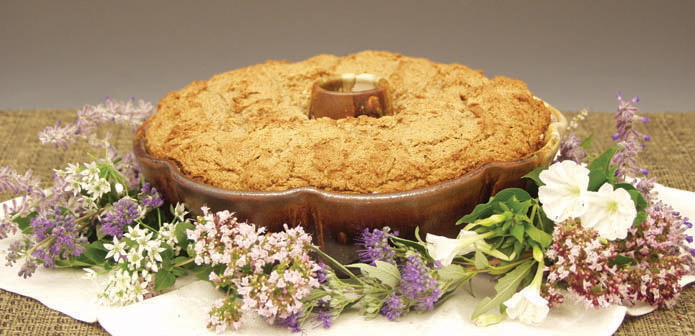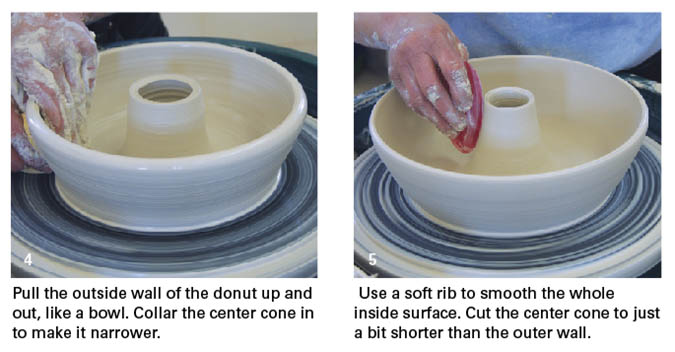

I have to admit, I never knew why bundt cake pans have the tube in the middle of the pan until I read Sumi von Dassow’s article in the Pottery Making Illustrated archive. Bundt cakes are shaped this way because it helps the cake cook evenly throughout! In case you’ve ever wanted to make your own custom bundt pan, I am excerpting from Sumi’s article in today’s post! Enjoy!
A bundt pan is a type of tube cake pan, which I rarely see made out of clay. Perhaps because of the conical center opening it just doesn’t occur to a lot of potters to try this form, but it’s actually surprisingly fun and simple to make. While
most recipes can be baked equally successfully in a loaf pan or a square or round cake pan, the purpose of the tube in the center isn’t merely decorative, it allows the cake to bake evenly from the center as well as the perimeter.

Throwing a Double-Walled Form
When throwing on the wheel, center 3 pounds of clay on a bat, and spread the centered mound out to about 8 inches across. Open the center all the way to the bat. Create a hole about 3 inches across in the center of the mound to create a donut shape (1). Wrap your hands over the sides, thumbs inside and fingers outside, to push down any clay that might have risen up around the opening and smooth the top of the donut. Now you can begin to open up the donut with your right thumb tip. You want to push your thumb tip into the donut pretty much as close to the center as you can. Create a channel in the donut (2), leaving only a ¼
inch of clay on the bottom—you won’t be able to trim a foot on the bundt pan. With your thumbs or fingertips, make the channel about 3 inches wide and flat across the floor.
Now you want to pull up the tube in the center, before you pull up the outer wall, so you don’t risk damaging the outer wall trying to work on the tube. With your left hand inside the donut hole, pull the inner wall up, working to pull up as much clay as you can from the bottom (3). Collar this tube in slightly, creating a smooth curve inside the bundt pan. Remember, the tube needs to narrow continuously toward the top of the pan or the cake won’t drop out. Trim the rim of the tube with a needle tool, leaving it about 3 to 3½ inches tall.

Now you can finish the outside of the pan, pulling up the wall just as you would the wall of a bowl. Make sure to allow the wall to widen slightly as you bring it up, again thinking about how the cake needs to come out of the form (4). Tip: You want to make sure the inner surface of the bundt pan is a smooth curve (5), with no undercuts. Even strong throwing rings might cause a cake to stick. Use a wood tool or a metal-bladed tool to trim as much excess clay from around the base of the outer wall as you can. If you want to flute the pan, you need to make sure you don’t have any excess to trim away at the leather-hard stage.
Use a needle tool to trim the rim of the outer wall to be just slightly shorter than the tube, since you will need to turn the cake pan over to refine the exterior. You can check this by laying a ruler across the rim. However, be aware that a cake will climb the pan a bit more on the inside than the outside, so be careful not to make the tube too short. You’ll be fine if you just remember not to over fill the pan with cake batter! Finally, trim as much as you can from around the base of the wall.







